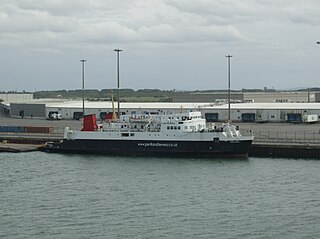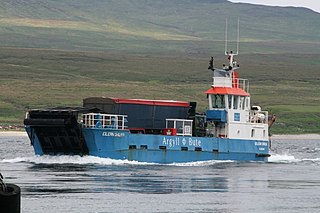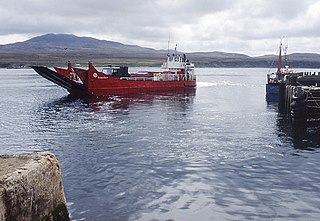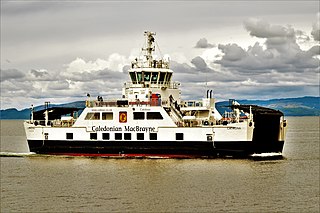
Argyll and Bute is one of 32 unitary council areas in Scotland and a lieutenancy area. The current lord-lieutenant for Argyll and Bute is Jane Margaret MacLeod. The administrative centre for the council area is in Lochgilphead at Kilmory Castle, a 19th-century Gothic Revival building and estate. The current council leader is Robin Currie, a councillor for Kintyre and the Islands.

Caledonian MacBrayne, usually shortened to CalMac, is the major operator of passenger and vehicle ferries, and ferry services, between the mainland of Scotland and 22 of the major islands on Scotland's west coast. Since 2006, the company's official name has been CalMac Ferries Ltd, although it still operates as Caledonian MacBrayne. In 2006, it became a subsidiary of holding company David MacBrayne, which is owned by the Scottish Government.

The Caledonian MacBrayne fleet is the largest fleet of car and passenger ferries in the United Kingdom, with 34 ferries in operation, 2 on charter and another 6 on order. The company provides lifeline services to 23 islands off the west coast of Scotland, as well as operating routes in the Firth of Clyde.

MV Hebridean Isles is a ro-ro vehicle ferry operated by Caledonian MacBrayne on the west coast of Scotland. She was the first MacBrayne vessel to be ordered and built for them outside Scotland and the first to be launched sideways. With bow, stern and side ramps, Hebridean Isles is suitable for all the routes served by the large fleet units. After 15 years crossing the Little Minch on the Uig triangle, she now serves Islay and Colonsay.

MV Isle of Arran is a drive-through ferry operated on the west coast of Scotland by Caledonian MacBrayne. Entering service in 1984, she served on the Arran route for nine years before being moved to Kennacraig. She returned to her original route in 2012, supplementing MV Caledonian Isles in summer and becoming a relief vessel in winter. In 2013, she started a new pilot route from Ardrossan to Campbeltown, which became a permanent fixture in 2015. As of 2023, she is one of the oldest vessels in the fleet, having been in service for 39 years.

West Loch Tarbert, Argyll is a long and narrow sea loch on the western side of the Kintyre peninsula in Scotland.

MV Pioneer is a stern / side loading ferry built in 1974, in service for 29 years covering nearly all of Caledonian MacBrayne's routes. She now serves the islands of São Tomé and Príncipe in the Gulf of Guinea and was chartered to rescue Liberian refugees.

MV Orion is a ro-ro passenger and vehicle ferry. Saturn was operated by Caledonian MacBrayne in the Firth of Clyde in Scotland between 1978 and 2011, for the first decade of her career on the Rothesay crossing. Later, she also saw service on the Dunoon and Brodick crossings, as well as on short cruises around the Clyde.

MV Pentalina-B was a ferry which operated on a variety of Scottish routes. Launched in 1970 as MV Iona, she was the first drive-through roll-on/roll-off ferry built for the David MacBrayne fleet. She was the first ship in the company's history to have bridge-controlled engines and geared transmission, rather than direct drive. During her career she inaugurated more endloading linkspans than the rest of the fleet put together. Purchased by Pentland Ferries in 1997, she was renamed MV Pentalina-B and operated across the Pentland Firth until the arrival of their new vessel. In 2009, she was sold to a Cape Verde owner.

MV Arran was a pioneering Firth of Clyde vehicle ferry introduced by Caledonian Steam Packet Company in 1953. She spent fifteen years on the Upper Clyde crossings, followed by five years at Islay. Initially hoist-loading, via side ramps, these were replaced by a stern ramp in 1973. During her final years with CalMac, she relieved across the network. Several unsuccessful attempts were made to turn her into a floating restaurant, before she was scrapped in 1993.

David MacBrayne is a limited company owned by the Scottish Government. Formed in 1851 as the private shipping company David Hutcheson & Co. with three partners, David Hutcheson, Alexander Hutcheson and David MacBrayne, it passed in 1878 to David MacBrayne.

Caledonian Maritime Assets Limited owns the ferries, ports, harbours and infrastructure for the ferry services serving the west coast of Scotland, the Firth of Clyde and the Northern Isles.

MV Eilean Dhiura is a vehicle ferry operating across the Sound of Islay.

MV Sound of Gigha was a pioneering roll-on/roll-off (ro-ro) ferry operating on the west coast of Scotland. She was launched as Isle of Gigha in May 1966. On 11 November 1966, she capsized off Islay. Salvaged, overhauled, and renamed, she provided thirty years of service between Islay and Jura.
MV Sound of Islay was the first ro-ro ferry on the west coast of Scotland. Built for Western Ferries in 1968, she served Islay and later Campbeltown – Red Bay. In 1981, she was sold to the Government of Newfoundland and Labrador and still operates in eastern Canada.

MV Sound of Jura was the first drive-through car ferry on the west coast of Scotland. It was operated by Western Ferries on the Islay service from Kennacraig between 1969 and 1976. The Mexican Government operated it to Cozumel as Quintana Roo until 2005, when it was wrecked by Hurricane Wilma.

MV Catriona is a pioneering diesel electric hybrid passenger and vehicle roll-on, roll-off ferry built for Caledonian MacBrayne for the Claonaig–Lochranza crossing. She is the third hybrid ferry commissioned and owned by Caledonian Maritime Assets, one of three such ferries in the world to incorporate a low-carbon hybrid system of diesel electric and lithium ion battery power. The ferries are sea-going and are nearly 46 metres (150 ft) long, accommodating 150 passengers, 23 cars or two HGVs.
MV Loch Sunart was a car and passenger ferry, originally operated in Amsterdam, and then by Western Ferries across the Firth of Clyde between Gourock and Dunoon in Scotland until October 2013. In 2018, Loch Sunart was converted into an ROV support vessel and is now owned by Caldive.

Sound of Seil is a car and passenger ferry, operated by Western Ferries on the upper Clyde between Gourock and Dunoon, Scotland.
























